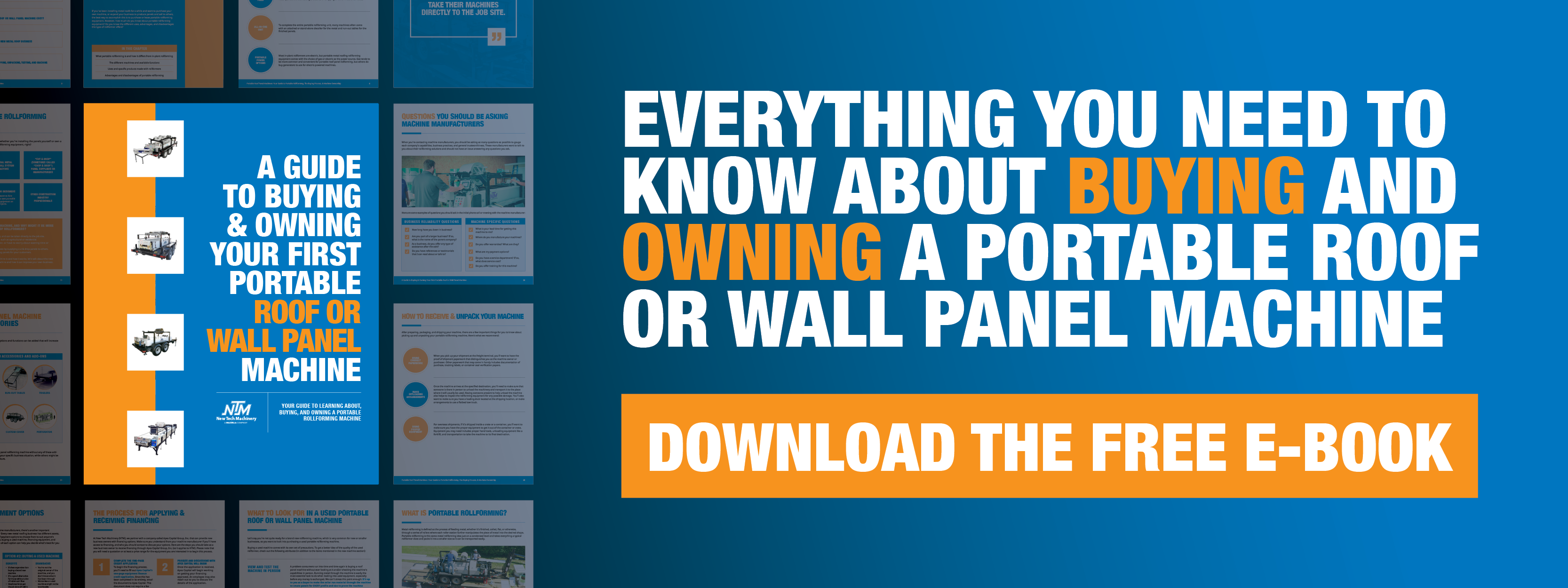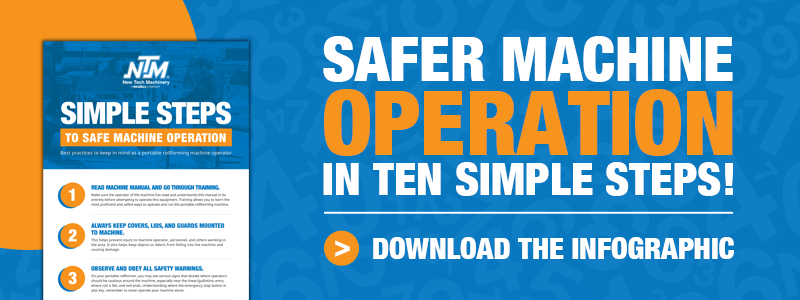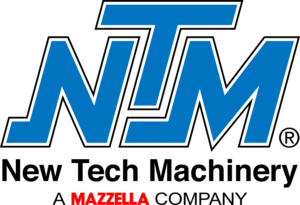What Are Rib Rollers? Application, Uses, and Types of NTM Rib Rollers
What are rib rollers in a portable roof panel machine? What makes it different from the panel profile or profile tooling in a portable rollforming machine? Knowing what rib rollers do, their uses in metal roofing, and what types of rib rollers are available with New Tech Machinery rollforming equipment can help you research and understand which rib to use in your metal roofing project.
At New Tech Machinery (NTM), we get this question a lot from people who think the rib rollers and forming rollers that make a profile are the same. The rib roller is not to be confused with the roller assemblies that make the panel profile and its male and female legs.
The panel leg is the upright portion of a finished metal roof panel on either side of the flattened portion. A rib is a raised portion inside the field of the panel that helps stiffen the panel and is often used for curb appeal and decoration. It’s not necessary for standing seam metal roofs, but it can help minimize the appearance of oil canning.
As you read this article, you’ll learn:
- What a rib roller is and how it is different than profile tooling
- Types of rib rollers available for portable roof panel machines
- Use cases for ribs in a metal roof panel
- How rib rollers work in an NTM machine
- Changeover and maintenance procedures of rib rollers
What Is a Rib Roller in a Portable Rollforming Machine?

A rib is a structural aspect formed in the flat part of the profiled panel, typically used to help make the finished styled panel more stiff or rigid. This is different than the male and female panel legs. Panel legs are the seams that get snapped or seamed together upon installation.
Ribs on a finished metal roof panel are formed during the rollforming process through a series of specifically styled rollers. They are simply a decorative aspect of the finished panel, not what makes the panel profile itself.
Adding ribs to your metal roof panels can help hide potential defects in the material itself, like if the coil was slit incorrectly. Ribs can also help hide rollforming machine problems (i.e., if too much pressure is inflicted on the metal). For example, if the machine is out of adjustment, it could cause oil canning and potentially deform the material. Certain ribs, like striation ribs, can help hide or minimize the appearance of oil canning during the installation process.
The rib roller assemblies offered by New Tech Machinery are a separate roller assembly entirely from the tooling set used to make a panel profile in a roof panel machine (snap-lock, mechanical lock, fastener flange, etc.). The rib roller assembly sits right behind the shear and consists of a frame and a set of top and bottom roller assemblies that form the ribs between the panel legs. The striation roller assembly uses the same frame but can utilize several top and bottom rollers depending on how many striations you want to put into the panel. They are an optional add-on or roof panel machine accessory that you can purchase but are not the same as the profile tooling sets or forming rollers inside a machine.
The panel profile tooling sets are the components inside the portable rollforming machine that bend and shape the material to a specified style and create the standing panel legs used for installing the panels to the roof. Profiles come in various types, including snap-lock, mechanical seam, and fastener flange.
Types of NTM Rib Rollers

When you purchase a new NTM roof panel machine (except for the 5VC Crimp machine), you have the choice of one matching pair of rib rollers in the style you wish (this includes a bottom and top rib roller assembly). The 5VC machine can only produce the striation ribs (optional).
Different types of rib rollers can make various minor ribs in a panel profile. Popular types of NTM rib rollers available with portable roof panel machines include the following:
Bead Ribs
Bead ribs are some of the widest ribs available on roof panel profiles. They make a rectangular indent into the panel when formed during the rollforming process. Available in standard (1.05” wide rib) or wide (2” wide rib) sizes, this flat rib is one of the most popular rib roller options for NTM roof panel machines like the SSQ II, SSR, and SSH.
Pencil Ribs
Pencil ribs are rounded ribs that give the shape of a half-circle when formed into the flat part of the panel. Available in small (.38”) and large (.68”) sizes, pencil ribs are available for the SSQ II, SSR, and SSH roof panel machines.
V-Ribs
V-ribs are similar to pencil ribs; however, instead of a rounded shape like pencil ribs, V-ribs have a slight crease in the middle so that they look like an upside-down “v” when installed onto the roof. NTM v-ribs are available in large (1.02”) and small (.37”) sizes for the SSQ II, SSR, and SSH machines.
Striations
Striations are formed by a series of offset rollers that bend the metal in different directions to achieve an “artificial waviness” between the finished panel’s legs. This waviness in the panel gives it structure and hides oil canning, possible defects in the panels, or improper installation issues when put on the roof.
Striation rollers, like all rib rollers, are adjustable, so you can make them deeper or less pronounced depending on your preference or specification in the project. NTM revised the striation assembly in 2010 / 2011, so contact the Service department if you’re looking for an older style of the striation roller assembly. You can use a striation roller assembly on the 5VC-5V Crimp, SSQ II, SSR, and SSH machines, although the striations for the 5VC machine are different than the other roof panel machines.
Clip Relief
Clip relief isn’t technically a rib, but it can help protect the metal from clips and screws potentially telegraphing through and causing a dent into the panel. Clip relief is a raised edge inside the frame of the panel that allows for a clip and fastener head to go underneath the panel and leaves enough room so that the fastener head doesn’t push up against the bottom of the panel and create distortion or a dent.
The clip relief assembly in an NTM machine is mounted on an eccentric shaft, so you can move them out of the way if you don’t want to use them when forming a profile in your roof panel machine.

Benefits of Using Ribs in Metal Roof Panels
As previously discussed, adding ribs to your metal roof panels is a great way to add decoration, stiffen the panel, and potentially hide any defects in the metal material or rollforming process. Ribs help to minimize or eliminate the appearance of oil canning. However, adding ribs into your metal roof panels is a personal preference. Some jobs or architects may specify not to use ribs in the project.
If you’re using the FWQ100 or FWQ150 flush wall /soffit profiles for a project, it is recommended to use the small pencil ribs or small v-ribs.
How NTM Rib Rollers Work
The top roller on an NTM rib roller assembly sits on an eccentric shaft, allowing you to engage or disengage the rollers to your liking. You can also slide the bead or rib roller assembly left or right depending on the width of the panel and where you want to put the ribs into the panel field. On all of the rib rollers, you can adjust the depth of the rib to make them shallower or deeper as desired.
If you’re using the striation rollers, adjusting the roller assembly left or right makes them narrower or wider depending on what your project calls for and how you want the panel to look. You can find directions for adjusting and setting up the rib roller, striation, or clip relief assembly on the SSQ II, SSH, or SSR roof panel machines in your machine manual.

How to Changeover and Maintain NTM Rib Rollers
Performing an entire rib roller changeover, adjusting them, and testing them can be time-consuming and costly from a labor standpoint.
The machine should never be operated without the guards in place. Otherwise, severe injury can occur. The machine must be operated by a competent, trained individual and never be operated by a person who has not had proper training, or studied the video and the latest operating manual found at www.newtechmachinery.com/resources/manuals. Failure to operate correctly or without guards can result in severe injury.
NTM recommends purchasing another roller frame if you’re going to offer different kinds of rib rollers to customers. By getting another frame, you can set up the rib roller assembly to the correct settings and just remove or install it as needed without having to continuously adjust it to the panel and materials you’re running for each project.
As part of your regular roof panel machine maintenance, you want to make sure to clean rib rollers routinely with acetone whenever they appear dirty. Also, keep the slide bars on the frame assembly lightly greased to allow the rollers to slide smoothly.
Proper storage (keeping your machine covered and indoors) is essential to not damage the rollers. Damage to your rollers can potentially result in scratches or indentations in your panel as it’s running through the machine.

Final Thoughts
Understanding what a rib roller is and how it’s different than the panel profile can help you better understand its uses in metal roofing and whether this optional accessory is worth purchasing and using with your portable roof panel machine.
Remember the following:
- Rib rollers only add a stiffening, raised shape (rib) to the flat part of a panel profile. It is not what makes the shape of the panel or the panel legs.
- They can make various styles of ribs, including bead, v-rib, striations, or pencil ribs.
- Rib rollers are a great way to help minimize the appearance of oil canning in a finished metal roof panel.
- You can easily engage or disengage the rib roller assembly, change where you’d like to put the ribs, and change the depth of the ribs just by adjusting the roller assembly.
If you’re looking for help in choosing the right rib roller for your roof panel machine or need more information about rib rollers and their uses in metal roofing, contact any of our rollforming specialists for assistance.

